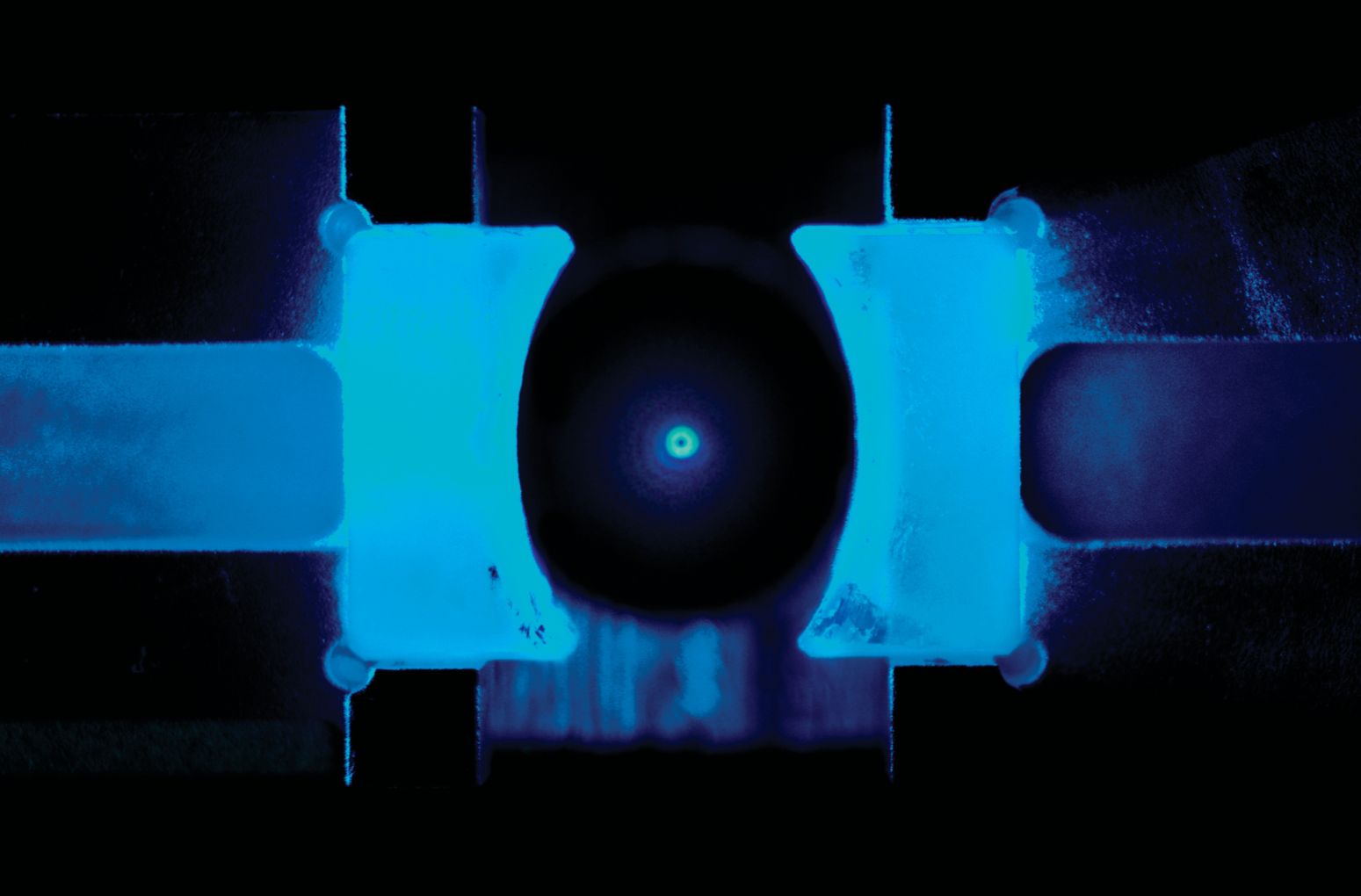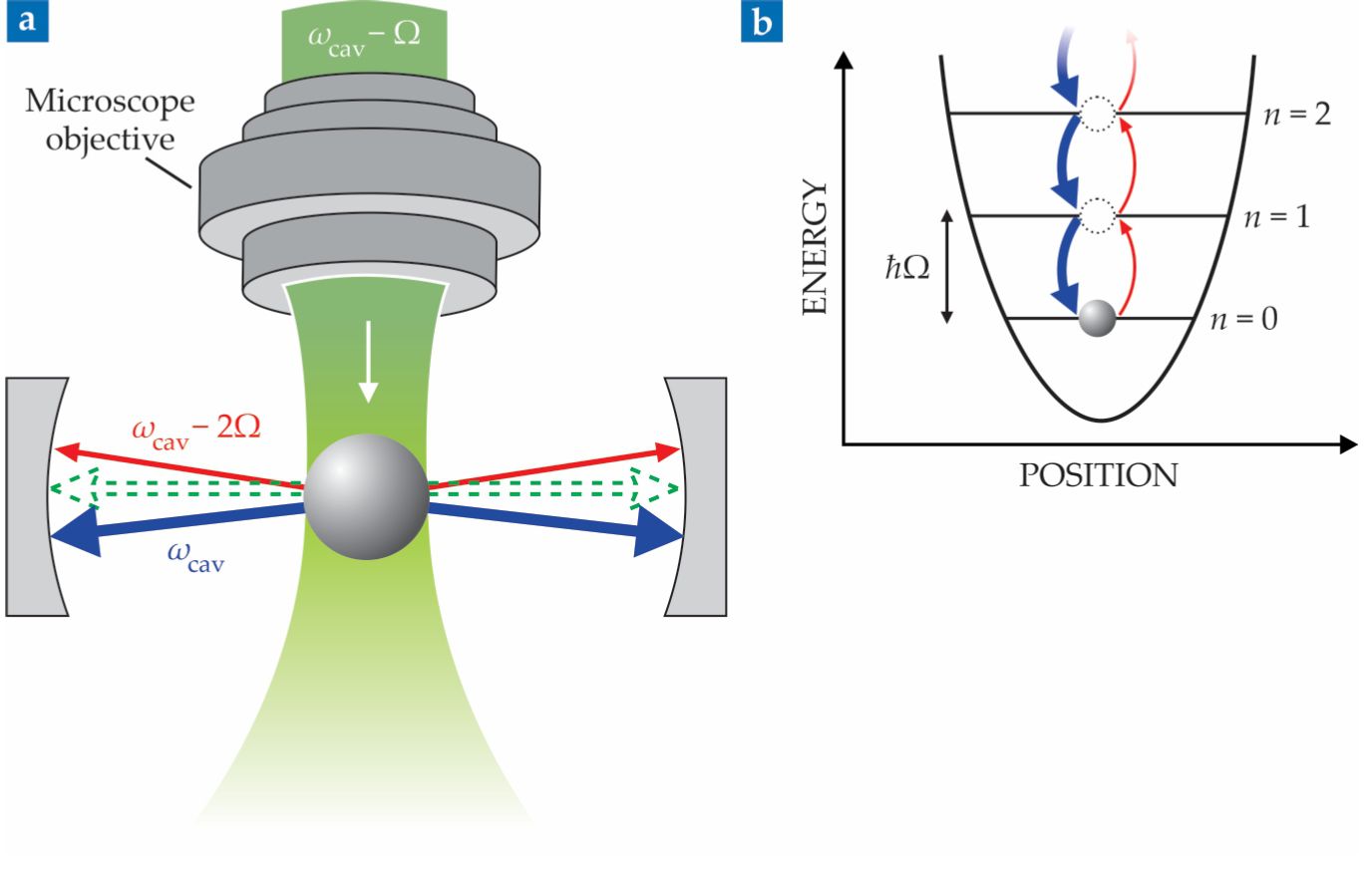An optical trap nudges a nanoparticle into its motional ground state
DOI: 10.1063/PT.3.4447
Macroscopic objects tend to behave classically rather than quantum mechanically—unless they can be cooled to ultralow temperatures. With a macroscopic quantum system, physicists could elucidate both the transition from classical to quantum and the causes of decoherence, including the role of gravity. Such systems would also have potential sensor applications for small forces (see Physics Today, October 2018, page 19
A suite of laser-cooling techniques has successfully pushed the temperature of atomic gases down to within a fraction of a degree above absolute zero, where quantum mechanics dictates their behavior. But the gases are not in macroscopic superposition states. Another potential route to macroscopic quantum systems is quantum optomechanics, in which an optical cavity is paired with a mechanical resonator of dimensions up to hundreds of millimeters (see the article by Markus Aspelmeyer, Pierre Meystre, and Keith Schwab, Physics Today, July 2012, page 29
Now Markus Aspelmeyer of the University of Vienna in Austria and his colleagues have demonstrated a strategy for an easily manipulated macroscopic quantum system.
1
They cooled a nanoparticle to its ground state, as depicted in figure
Figure 1.

An optically trapped nanoparticle, shown here through its dipole scattering (blue dot), is cooled to its ground state inside an optical cavity about 1 cm wide. (Courtesy of the University of Vienna.)

From atoms to nanoparticles
Extending laser-cooling techniques to molecules and solids has proven tricky. The most common technique, Doppler cooling, irradiates the sample from all sides with laser light that is tuned slightly below the frequency of an atomic transition. When an atom moves in the opposite direction of a photon, the light is blueshifted into resonance and absorbed. The atom then slows down, reemits the light, and returns to its ground state.
Repeating that absorption and emission tens of thousands of times can cool a sample to temperatures as low as tens of microkelvins. But a molecule’s rotational and vibrational degrees of freedom split the energy levels. Therefore, when a molecule reemits light, it can get stuck in a state other than the ground state and actually gain energy in the process (see Physics Today, January 2010, page 9
About 20 years ago, Helmut Ritsch and, independently, Vladan Vuletić and Steven Chu proposed a different method called cavity cooling. 2 It relies on coherent scattering in an optical cavity irradiated by a laser, which doesn’t need to be tuned to an electronic transition. The cavity field traps the atom or molecule, and when the light in the cavity scatters off it, the particle is left in either a higher motional energy state, so-called Stokes scattering, or a lower motional energy state, anti-Stokes scattering. The driving laser is tuned such that the cavity enhances anti-Stokes scattering, and each photon scattered into the cavity lowers the energy of the particle one quantum of motion, or phonon, at a time.
In theory, that tactic should cool a nanoparticle to its motional ground state. As Uroš Delić finished his undergraduate thesis in preparation for grad school, he and Aspelmeyer were eager to try cavity cooling on a solid particle, an effort pursued by a few groups, including that of Lucas Novotny at ETH Zürich. But any effort to reduce the temperature below tens of millikelvin, or several hundred phonons, faces two hurdles. First, fluctuations in the laser’s phase cause cavity-field fluctuations that jostle the particle and heat it. Second, cooling the nanoparticle further than tens of millikelvin requires more photons—that is, the laser intensity needs to be increased. But a strong cavity field pulls the particle into one of the field’s antinodes, where the particle motion no longer interacts with the cavity field and thus isn’t cooled.
After an internship in Vuletić’s lab at MIT, Delić altered the cavity-cooling setup in Aspelmeyer’s lab to remove those obstacles. In their cooling scheme, shown in figure
Figure 2.

In the optical cooling scheme, a nanoparticle reaches its ground state through coherent scattering. (a) An optical trap (green) holds the particle (gray sphere) inside an optical cavity with resonant frequency ωcav. Photons scatter off the particle, and the cavity enhances anti-Stokes scattering (blue arrows) over Stokes scattering (red arrows). The nanoparticle’s position in the cavity suppresses elastic scattering (green dashed arrows). (b) Anti-Stokes scattering lowers the energy of the particle one phonon at a time, whereas Stokes scattering increases it. Each phonon has a frequency of Ω and an energy of ℏΩ. (Adapted from ref.

Otherwise, the process is similar to the usual cavity cooling: Photons from the trap scatter off the particle, and rather than enhancing Stokes scattering (smaller red arrows), the cavity enhances anti-Stokes scattering (blue arrows in figure
Fine tuning
The nanoparticle’s temperature is the sum of the phonons’ energies. To measure the number of phonons, Aspelmeyer and his team collect the scattered light and identify the frequency peaks from Stokes and anti-Stokes scattering. The evolving asymmetry of those peaks indicates the average number of phonons
In the experiment, the team members cooled a 143-nm-diameter silica nanoparticle down to its ground state, which corresponds to a temperature of about 12 µK. The lowest value of
To optimize the cooling, Aspelmeyer’s group members detuned the optical trap by different frequencies relative to the cavity resonance, as shown in figure
Figure 3.

The average number of phonons

Room for expansion
Now that Aspelmeyer has cooled a nanoparticle to its ground state, he says, “What I would really love to see is a wavepacket that is the size of the object.” In the current experiment, the nanoparticle’s wavepacket is localized to a few picometers. But a wavepacket as big as the particle itself would allow researchers to examine its properties in the macroscopic quantum regime.
Expansion of the wavepacket is possible by swapping the trap’s beam profile from a harmonic potential to a double well or any number of nonlinear potentials. Engineering particle dynamics quickly and on the fly through the beam profile is something the cold-atom and biophysics community has been doing successfully for years with optical tweezers. The particle stays trapped, and the potential landscapes evolve around it.
Another method to expand the wavepacket is turning off the optical trap and letting the particle fall. With the current setup, a freely falling wavepacket would have time to expand by only a factor of three before it decohered. Lowering the pressure to 10−11 mbar and the surrounding temperature below 130 K would preserve coherence for long enough, about 10 ms, for the wavepacket to expand to a size on the order of the particle radius.
Aspelmeyer’s long-term vision is to apply his technique to particles that are large enough to produce a measurable gravitational field. In that regime, questions about how the gravitational field looks for an expanded wavepacket can be answered. But Aspelmeyer says those experiments are still a decade or two away.
References
1. U. Delić et al., Science 367, 892 (2020). https://doi.org/10.1126/science.aba3993
2. P. Horak et al., Phys. Rev. Lett. 79, 4974 (1997); https://doi.org/10.1103/PhysRevLett.79.4974
V. Vuletić, S. Chu, Phys. Rev. Lett. 84, 3787 (2000). https://doi.org/10.1103/PhysRevLett.84.37873. U. Delić et al., Phys. Rev. Lett. 122, 123602 (2019); https://doi.org/10.1103/PhysRevLett.122.123602
D. Windey et al., Phys. Rev. Lett. 122, 123601 (2019). https://doi.org/10.1103/PhysRevLett.122.1236014. F. Tebbenjohanns et al., Phys. Rev. Lett. 124, 013603 (2020). https://doi.org/10.1103/PhysRevLett.124.013603




